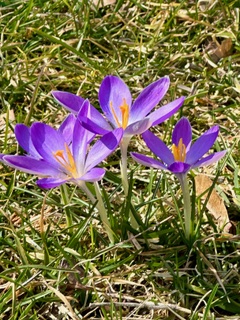Spring is here and our gardens need attention.
Shear perennials left standing last fall. Cut back ornamental grass, sedum and carex. Give them a hard trim to the ground. Remove old Hellebore leaves, trim Epimedium and last year’s fern fronds before new growth begins. Cut back any vinca or ivy browned by harsh winter winds, but leave browned rhododendrons alone for now and prune after blooming.
Dig and divide perennials as soon as their new shoots appear. Most perennials will benefit from division every 3 to 5 years in order to rejuvenate plants and ensure abundant blooms from year to year. When dividing older perennials, discard the center of each clump and replant sections from the outer areas where shoots are more vigorous.
As spring bulbs start to decline, remember that it’s important not to cut back the foliage. After flowering, the plants continue to photosynthesize and are storing food reserves in the bulb for next spring. Foliage should be left until it naturally yellows and begins to die back. Planting annuals around bulbs is a great way to hide the remaining bulb foliage. Planting late spring and early summer perennials that begin to emerge as the bulbs fade is also a great method of hiding bulb foliage.
Keep off the grass when the soil is wet to prevent compaction. It reduces the spaces available for oxygen making it difficult for grass roots to grow. This will have negative consequences for the lawn when the weather gets hot and dry. Grass plants with reduced root systems struggle for survival under such stress.
Be sure the lawn is dry before raking, to remove branches, stones and other debris. Fertilize only if a late fall application was not made.
Do not work your soil when it is wet; it will damage the soil structure. Use the squeeze test. Take a handful of soil and squeeze it. If the soil crumbles easily when you open your hand, it is ready to be dug. It is not ready if water comes out.
Prune summer and fall flowering shrubs now. The appearance of Forsythia flowers is a good indicator to prune: butterfly bush (Buddleia), smoke bush (Cotinus), Hydrangea ‘Annabelle’, beautyberry (Callicarpa), panicle Hydrangea, summer sweet (Clethra), sweetspire (Itea) and Spirea.
Hydrangeas that bloom on last year’s old wood should be pruned after flowering. Remove only dead stems at this time. Prune climbing Hydrangea and train it to a vertical support. Wait to prune spring flowering shrubs until they have completed blooming.
Prune out winter breakage as soon as seen. With broadleaf evergreens such as Rhododendron, boxwood, and holly, wait a month or two to see if the browned leaves will drop off and re-leaf naturally.
A soil test should be performed every three years to monitor soil pH and fertility levels. It will provide information on soil nutrient levels and fertilizer recommendations. Fall is the best time for adding amendments but it can also be done in the spring. Details are available online through the University of Massachusetts.
Judy Dembsey is the director of the Acton Garden Club.

